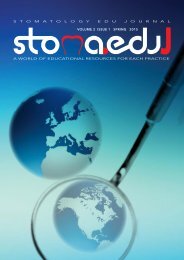Stomatology Edu Journal 1/2014
You also want an ePaper? Increase the reach of your titles
YUMPU automatically turns print PDFs into web optimized ePapers that Google loves.
cariology<br />
Table 3. Results regarding the changes of dentine consistency (in accordance with different bioactive materials)<br />
Group 1/<br />
Ca(OH) 2+ZOE<br />
Group 2/<br />
ZOE<br />
Group 3/ Ca(OH) 2 +<br />
glassionomer cement<br />
Hard 50% 40% 30%<br />
Leather 40% 40% 50%<br />
Soft 10% 20% 20%<br />
Table 4. Mann Whitney statistical test results when comparing the consistency changes of the dentine after<br />
6 months; Group 1-Ca(OH) 2+ZOE; Group 2-ZOE; Group 3-Ca(OH) 2+glassionomer cement<br />
Group 1 Group 2 Group 3<br />
Group 1 - 0.565 0.344<br />
Group 2 0.565 - 0.744<br />
Group 3 0.344 0.744 -<br />
(Dycal, DeTreyDentsply) and zinc-oxyde-eugenol<br />
(Caryosan, Spofa Dental); group 2 (10 acute dental<br />
caries) zinc-oxyde-eugenol (Caryosan, Spofa Dental);<br />
group 3 (10 acute dental caries) - calcium-hydroxide<br />
liner (Dycal, DeTreyDentsply) and glassionomer cement<br />
(Ketac Molar Easymix, 3M ESPE). The assessment of<br />
the affected dentine was performed using two criteria:<br />
the color (yellow, brown-yellow, dark-brown) and<br />
the consistency (soft, leather, hard) immediately after<br />
completing the excavation procedure and 6 months<br />
later. The presence of dentine remineralisation was also<br />
assessed on the radiographic images. The vitality tests,<br />
assessing the vitality of pulp tissue, were performed<br />
using an electric pulp test device (Digitest, Parkell Inc,<br />
USA). Statistical analyzes of the results were performed<br />
using the Mann Whitney test with a significance level<br />
p0.05) (table 2).<br />
Table 3 presents the results regarding the<br />
consistency changes (Leksell indices) after 6 months.<br />
Study group 1 (Ca(OH) 2 + zinc-oxyde-eugenol)<br />
included 50% cases with hard dentine (total<br />
remineralisation), 40% cases with leather consistency<br />
(partial remineralisation) and only 10% cases with<br />
soft dentine (absent remineralisation). Study group<br />
2 (zinc-oxyde-eugenol) included 40% cases with<br />
hard dentine (total remineralisation), 40% cases with<br />
leather consistency (partial remineralisation) and<br />
20% cases with soft dentine (absent remineralisation).<br />
Study group 3 (Ca(OH) 2 + glassionomer cement)<br />
included 30% cases with hard dentine (total<br />
remineralisation), 50% cases with leather consistency<br />
(partial remineralisation) and 20% cases with soft<br />
dentine (absent remineralisation).<br />
No significant statistical differences were obtained<br />
when comparing consistency changes of the dentine<br />
after 6 month in groups 1, 2 and 3 (p>0.05) (table 4)<br />
An analysis of the radiographic images showed<br />
that in the study group 1 (Ca(OH) 2 + zinc-oxydeeugenol)<br />
dentine remineralisation was present in 90%<br />
of the cases. In this study group, the remineralisation<br />
processes were absent in 10% of the cases. This was<br />
the lowest percent of failure from all the study groups.<br />
In study group 2 (zinc-oxyde-eugenol) dentinal<br />
remineralisation was present in 80% of the cases.<br />
In study group 3 (Ca(OH) 2 + glassionomer cement)<br />
dentinal remineralisation was present in 80% of the<br />
cases. In Figure 1 is presented the radiographic<br />
aspect of demineralised dentine in deep acute<br />
carious lesion at 46 tooth. Figure 2 presents<br />
the radiographic aspect after 6 months of pulp<br />
capping with Ca(OH)2 and ZOE. It can be seen the<br />
area of dentinal remineralisation associated with<br />
neodentinogenesis and retraction of pulp beneath<br />
the mesial horn (Figure 2).<br />
Pulp tissue vitality was preserved in 100% of the<br />
cases in the study group, 6 months after indirect pulp<br />
14 Stoma.eduJ (<strong>2014</strong>) 1 (1)




